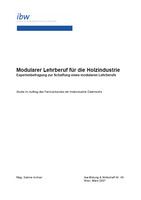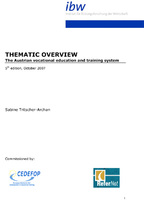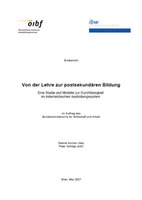Die Erhöhung der Flexibilität bei der Gestaltung der Ausbildung, die Abdeckung von vielseitig geäußerten Lehrberufswünschen seitens der Betriebe sowie die damit verbundene Ausweitung potenzieller Lehrbetriebe waren die Hauptgründe für die Konzipierung des Modullehrberufs „Industrielle Holztechnik“ durch den Fachverband der Holzindustrie Österreichs. Im November 2006 wurde das Institut für Bildungsforschung
der Wirtschaft (ibw) beauftragt, Firmenvertreter aus den Bereichen Bau, Möbel, Platte und Säge über ihre Meinung zum vorgeschlagenen Lehrberuf zu befragen. Das Ergebnis: Sowohl der modulare Aufbau als auch die Inhalte der einzelnen Module werden von den Branchenexperten überwiegend positiv bewertet. Der Großteil der Firmen – darunter auch viele, die derzeit nicht in die Lehrlingsausbildung involviert sind –, signalisiert ihre Bereitschaft, Lehrlinge im vorgeschlagenen Modullehrberuf auszubilden. Mit der Etablierung dieses Berufes könnte daher eine bestehende Bedarfslücke geschlossen werden.
The desire to increase flexibility in the design of the educational program, to address the widely ex-pressed requests for apprenticeships of the companies, and the related expansion of potential compa-nies for providing apprenticeship training were the main reasons that the Fachverband der Holzindus-trie Österreichs (Association of the Austrian Wood Industries) developed the concept of the modular appren-ticeship “Industrial Wood Technology”. In November 2006, the Institut für Bildungsforschung der Wirtschaft (ibw – Institute for Research on Qualifications and Training of the Austrian Economy) was commissioned to survey company representatives in the construction, furniture, board and saw mill sectors regarding their opinion of the proposed apprenticeship. The results: Both the modular design as well as the contents of the individual modules were given predominately positive evaluations by the experts from the various sectors. A majority of the companies, including many who are currently not involved with apprenticeship training, ex-pressed their readiness to train apprentices in the proposed modular apprenticeship. Establishing this voca-tion could thus close an existing demand gap.



